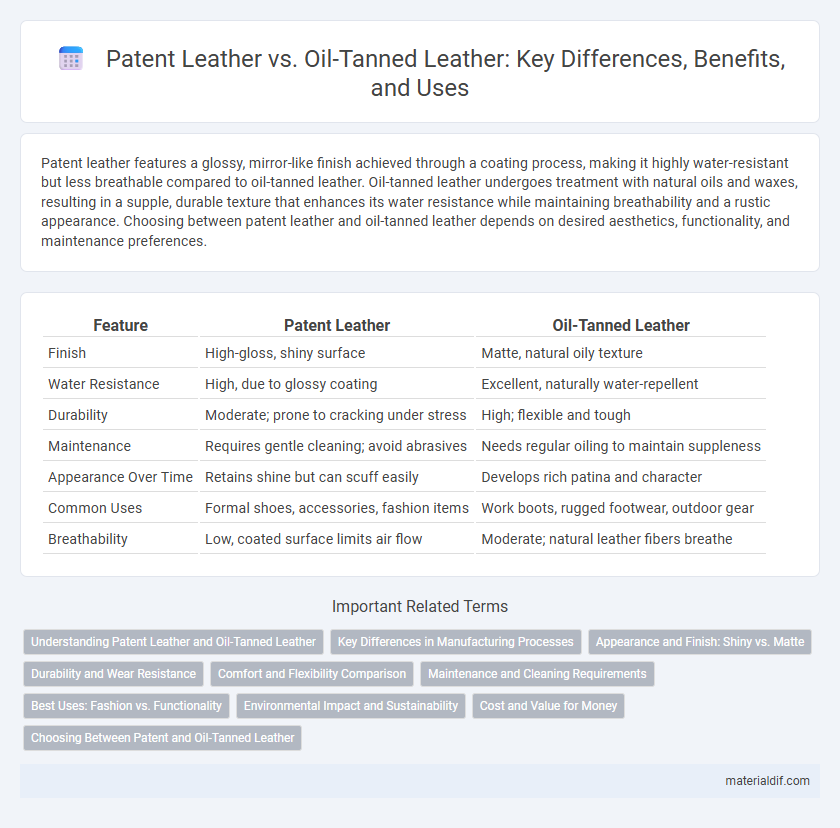Patent leather features a glossy, mirror-like finish achieved through a coating process, making it highly water-resistant but less breathable compared to oil-tanned leather. Oil-tanned leather undergoes treatment with natural oils and waxes, resulting in a supple, durable texture that enhances its water resistance while maintaining breathability and a rustic appearance. Choosing between patent leather and oil-tanned leather depends on desired aesthetics, functionality, and maintenance preferences.
Table of Comparison
| Feature | Patent Leather | Oil-Tanned Leather |
|---|---|---|
| Finish | High-gloss, shiny surface | Matte, natural oily texture |
| Water Resistance | High, due to glossy coating | Excellent, naturally water-repellent |
| Durability | Moderate; prone to cracking under stress | High; flexible and tough |
| Maintenance | Requires gentle cleaning; avoid abrasives | Needs regular oiling to maintain suppleness |
| Appearance Over Time | Retains shine but can scuff easily | Develops rich patina and character |
| Common Uses | Formal shoes, accessories, fashion items | Work boots, rugged footwear, outdoor gear |
| Breathability | Low, coated surface limits air flow | Moderate; natural leather fibers breathe |
Understanding Patent Leather and Oil-Tanned Leather
Patent leather is characterized by its glossy, mirror-like finish achieved through a coating process that provides water resistance and a smooth surface, making it ideal for formal footwear and accessories. Oil-tanned leather undergoes a treatment with natural oils, resulting in a durable, water-repellent material with a soft, supple texture prized for rugged, long-lasting goods like boots and outdoor gear. Understanding these differences helps in selecting leather based on desired aesthetics, functionality, and durability.
Key Differences in Manufacturing Processes
Patent leather undergoes a coating process involving a lacquer or varnish finish that creates its characteristic glossy, smooth surface, while oil-tanned leather is treated with oils and waxes that penetrate deeply, resulting in a supple, water-resistant texture. The manufacturing of patent leather includes multiple layers of polymer or synthetic coatings that solidify into a high-shine layer, whereas oil-tanned leather relies on natural tanning oils and hand-rubbing techniques to enhance durability and flexibility. These distinct processing methods impact the final product's appearance, flexibility, and resistance to moisture and wear.
Appearance and Finish: Shiny vs. Matte
Patent leather features a highly polished, glossy finish achieved through a coating process that creates a mirror-like shine, making it ideal for formal footwear and accessories. Oil-tanned leather, on the other hand, exhibits a natural, matte appearance with a soft, supple texture that highlights the leather's grain and character. The shiny surface of patent leather contrasts sharply with the subdued, understated finish of oil-tanned leather, catering to different aesthetic preferences and functional uses.
Durability and Wear Resistance
Patent leather features a glossy, polyurethane coating that offers excellent water resistance and protects against scratches but can crack over time with heavy bending. Oil-tanned leather is treated with oils and waxes, providing superior flexibility, durability, and natural water resistance, making it highly resistant to wear and aging. For long-lasting use in rugged conditions, oil-tanned leather outperforms patent leather in terms of durability and wear resistance.
Comfort and Flexibility Comparison
Patent leather features a glossy, rigid surface due to its lacquer coating, which limits its flexibility and can reduce comfort during extended wear. Oil-tanned leather absorbs oils during processing, resulting in a softer, more pliable material that conforms better to the wearer's foot, enhancing comfort and flexibility. The oil-tanning process preserves the leather's natural breathability and suppleness, making it ideal for footwear requiring long-lasting comfort and ease of movement.
Maintenance and Cleaning Requirements
Patent leather requires regular wiping with a soft, damp cloth to maintain its glossy finish and prevent cracking, while avoiding harsh chemicals that can damage its surface. Oil-tanned leather benefits from periodic conditioning with leather-specific oils or creams to preserve its suppleness and water resistance, as it is more porous and absorbs moisture more readily. Both types demand gentle care routines tailored to their unique textures to ensure long-lasting durability and appearance.
Best Uses: Fashion vs. Functionality
Patent leather excels in fashion applications due to its high-gloss finish and smooth surface, making it ideal for formal footwear, handbags, and accessories that require a polished, stylish appearance. Oil-tanned leather offers superior durability and water resistance, making it well-suited for rugged outdoor gear, work boots, and functional items that demand long-lasting performance and protection. The choice between patent leather and oil-tanned leather ultimately depends on whether the priority is aesthetic appeal or practical functionality.
Environmental Impact and Sustainability
Patent leather, coated with synthetic polymers, poses environmental challenges due to the non-biodegradable finishes and toxic chemical use in production, leading to landfill waste and pollution. Oil-tanned leather, treated with natural oils, offers better biodegradability and often involves fewer harmful chemicals, enhancing its sustainability profile. Choosing oil-tanned leather supports reduced environmental impact through renewable resources and lower chemical emissions compared to patent leather's synthetic coatings.
Cost and Value for Money
Patent leather typically commands a higher price due to its glossy, polished finish and labor-intensive production process, making it a premium choice for formal footwear and accessories. Oil-tanned leather, known for its durability and water resistance, offers excellent value for money in outdoor and heavy-use applications, often costing less than patent leather while providing long-lasting performance. Choosing between the two depends on the intended use, with patent leather excelling in style and oil-tanned leather in ruggedness and cost efficiency.
Choosing Between Patent and Oil-Tanned Leather
Patent leather offers a glossy, smooth surface ideal for formal footwear and accessories, while oil-tanned leather provides a rugged, durable texture suitable for outdoor and heavy-use items. Choosing between patent and oil-tanned leather depends on the desired balance of aesthetic appeal and functionality, with patent leather emphasizing shine and elegance, and oil-tanned leather prioritizing resilience and water resistance. Consider the usage environment and maintenance requirements to select the leather type that best matches your specific needs.
Patent Leather vs Oil-Tanned Leather Infographic

 materialdif.com
materialdif.com